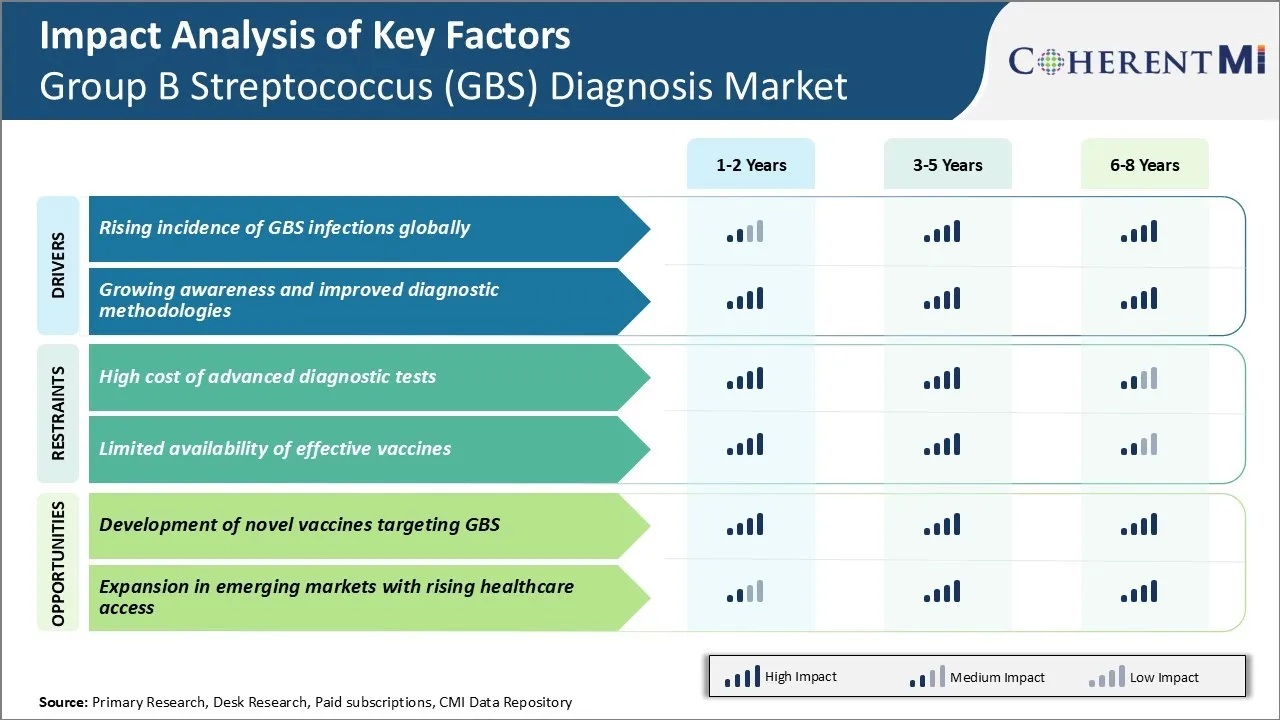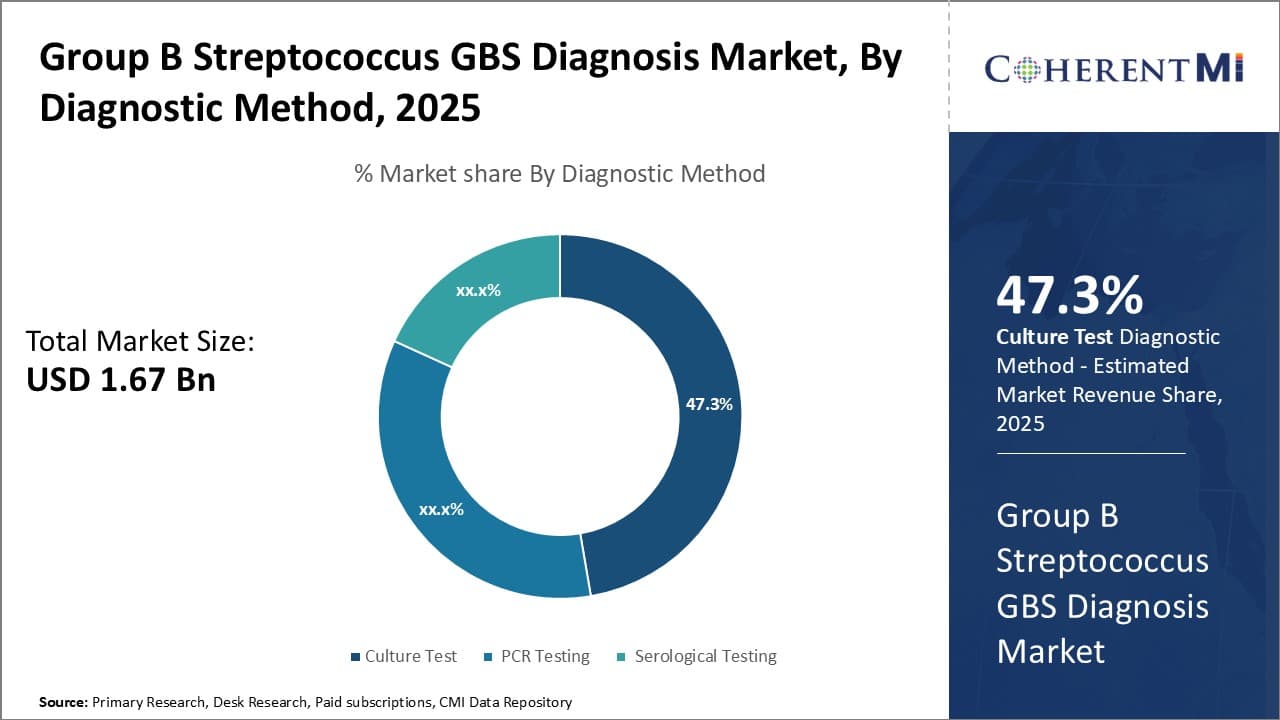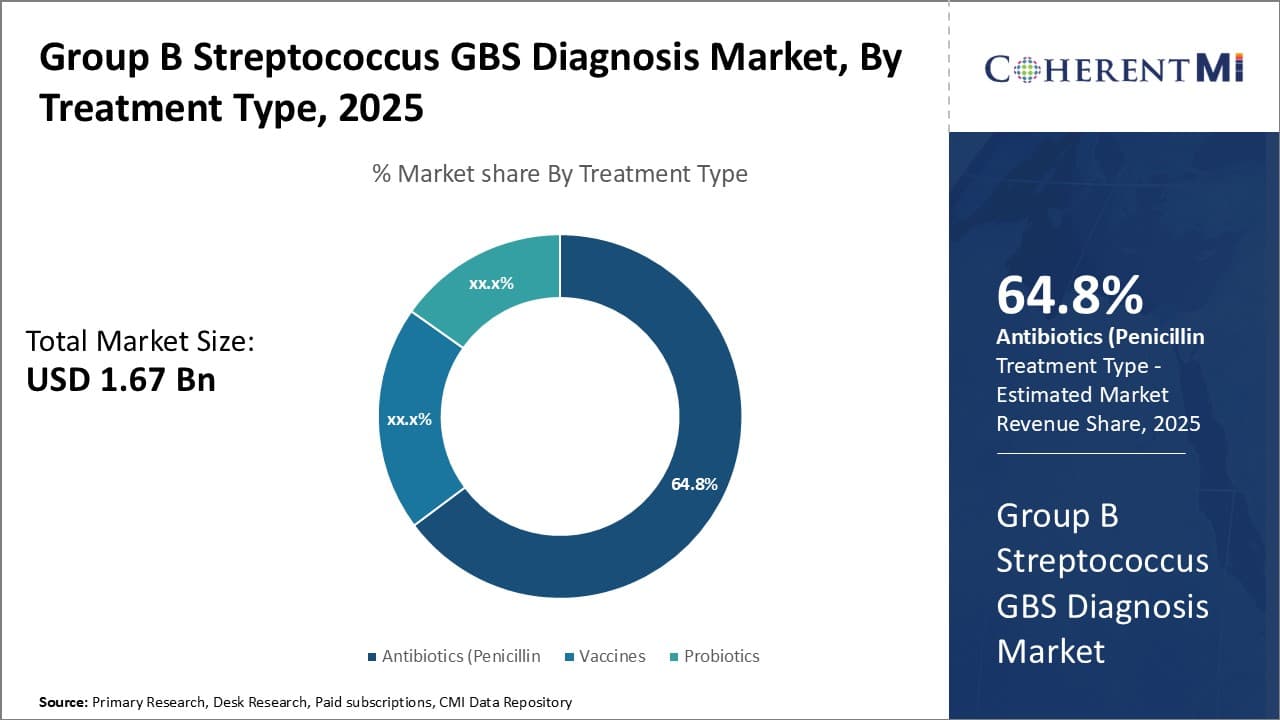グループB連鎖球菌GBS診断市場 サイズ - 分析
グループB streptococcus(GBS)診断市場は評価されると推定される 2025年のUSD 1.67億 そして到達する予定 2032年までのUSD 2.45億、混合の年次成長率で育つ 2025〜2032年(CAGR) スクリーニング技術の急速な進歩と妊娠中のGBS感染に関する成長意識は、予測期間中にグループB streptococcus(GBS)診断市場を運転することが期待されています。
市場規模(米ドル) Bn
CAGR5.6%
| 調査期間 | 2025-2032 |
| 推定の基準年 | 2024 |
| CAGR | 5.6% |
| 市場集中度 | Medium |
| 主要プレーヤー | 株式会社Pfizer, ノバルティスAG, マーク&株式会社, グラクソスミスクライン plc, サノフィ その他 |
お知らせください!
グループB連鎖球菌GBS診断市場 トレンド
市場ドライバー - グローバルにGBS感染の有利化
世界中のGBS感染の発生率は、GBS診断市場の成長に著しく貢献しています。 GBSは、新生児における敗血症や髄膜炎などの生命を脅かす感染症のリーディング原因の一つです。 開発途上国における侵襲的なGBS病変の割合が低下しても、一定の地域は、初期設定および乳幼児のGBS感染の傾向を観察し続けています。
公衆衛生の公式による最近の見積もりによると、毎年5万人の赤ちゃんがGBSに感染し、20,000を超える死亡率を上回っています。 死のつま先は妊娠した女性をスクリーニングし、扱うための改善された議定書と一貫して高く残ります。 アジア・パシフィックとアフリカの国々を発展させるには、新生児のGBS感染に対する最も高い報告されたケース・ファティリティ・レートがあります。
強化されたリスクは、より効果的な予防戦略を実施するために、政府や医療機関を支持しています。 35~37週間の妊娠を急激な診断試験で実施する妊婦の普遍的なスクリーニングに近づく。 キャリアのタイムリーな識別は、peri-partum抗生物質の予防接種率で非常に成功しました。 しかしながら、資源の制約は、特に低・中所得の国では、高疾患の優先順位でスクリーニング努力を妨げ続ける。 これは費用効果が大きいおよび急速なポイントの心配の診断テストのための要求を増幅しました。
市場ドライバー - 認知度を高め、診断方法を改善
GBS感染とその健康への影響に関する成長意識は、タイムリーなスクリーニングと診断を奨励することにより、市場成長に積極的に貢献しています。 以前、GBSは、合併症が設定されたときに、大幅な脅威と診断はしばしば遅れて起こりませんでした。
迅速で信頼性の高い診断オプションを提供することで、ここに重要な役割を担っています。 細菌のculturingのような従来の診断テストは女性がGBSのキャリアであるかどうか確認するために2-3日かかります。 長いターンアラウンドは、タイムリーな抗生物質の予防接種を提供する能力を厳しく制限しました。 しかし、ポリメラーゼチェーン反応(PCR)や酵素免疫測定など、より高速な分子技術は、数時間以内に腟/四角形のワブからGBSを検出できるようになりました。 遠隔地でも、ポイント・オブ・ケアの試験能力を拡充し、ケースの検出力を高めています。
さらに、新しいプラットフォームは、複雑なサンプルからアンザードまでのワークフローや専門機器やトレーニングの要件など、既存の制限を克服するために開発されています。 シンプルな横流免疫測定は、近傍または家庭用の迅速な検査のための有望な選択肢として新興しています。 自己回収能力を持つPOCテストは、リソース制限領域で非常に望ましいでしょう。 このようなユーザーフレンドリーなイノベーションは、スクリーニングの遵守を改善し、迅速な診断へのアクセスを実質的に期待しています。
 このレポートの詳細については、サンプルコピーをリクエストする
このレポートの詳細については、サンプルコピーをリクエストする
市場課題 - 高度な診断テストのコスト
現在、グループB Streptococcus(GBS)診断市場が直面する主要な課題の1つは、高度な診断テストのコストが高いです。 PCRおよび文化ベースの診断テストのような金標準的な診断方法は、これらのテストを頻繁に使用するためにかなり高価にさせる専門装置および試薬を必要とします。
PCRテストは、高精度でGBSを検出することができますが、重要なコストは、特にリソースが限られている途上国の開発に、その広範な採用を制限します。 この高価なポーズは手頃な価格の問題であり、GBSのコロナライゼーションのために妊婦の普遍的なスクリーニングを防ぐことができます。
さらに、高度なGBSテストは、リモートエリアのアクセシビリティを妨げる特殊な研究所でのみ実行できます。 これらのテストの高価な性質はまた、感染した母親のタイムリーな発砲抗バイオプロティック予防接種のために重要な繰り返しテストを減少させます。 低コストの代替手段は開発されず、大規模なスクリーニングプログラムを通じてGBS感染を抑制する金融障壁は継続します。
市場機会 - GBSをターゲットとするノベルワクチンの開発
GBS診断市場での利害関係者のための1つの主要な機会は、GBSをターゲットとする新規ワクチンの開発にあります。 現在利用できる診断テストは活動的な GBS のコロニゼーションか伝染の検出だけを許可しますが、将来の発生に対して保護を提供します。 これは、繰り返しスクリーニングと診断の必要性を排除することができる予防ワクチンの要求を燃料化しました。
費用対効果の高いGBSワクチンを設計し、クロスセロタイプの保護を提供します。 そのようなワクチンの成功的な発展は、GBS病の発生率をグローバルに抑制し、広範な診断試験の必要性を排除します。
また、ワクチンメーカーの有利な収益源を開くこともできます。 これにより、プレイヤーがワクチン接種の予防的アプローチに資金を供給するためのマルチ億ドルの商用機会が提供されます。 ノベルGBSワクチンは、治療に関連する医療費を大幅に削減し、GBS感染の長期管理も大幅に低下する可能性があります。
処方者の好み グループB連鎖球菌GBS診断市場
GBSは、通常、妊娠中の感染を防ぐため、妊娠中および配達中の抗生物質の組み合わせによって処理されます。 妊娠中の喘息菌のために、処方者は一般的にペニシリンまたはアモキシシリンの最初のライン経口レジメンをお勧めします。 患者がペニシリンにアレルギーがある場合、代わりにセファレンシン(セポレックス)を処方することができる。
妊娠した女性のために chorioamnionitis または膜の前期の破裂症を経験します, 不利な代理店は、感染のリスクの増加のために好まれています. 一般的な選択肢には、ペニシリンG(クリスタペン)、アンピシリン(オキシド)、またはセファゾリン(セファゾリンカビ)が含まれます。 哺乳類のリスクが保証される場合、シンダマイシン(ダラシン)やバコキシン(バナコシン)などの第二線の選択肢も考慮されます。
GBS陽性母親のための配達中、第一線の予防接種は、通常、配達直前にペニシリンGまたはアンピシリンの静脈内投与を含みます。 重度のペニシリンアレルギーを持つ人のために、Vancomycinは標準的な代替品です。 複雑でない腟配達の後で、新生児は初期設定GBS病気の徴候のために監視され、必要に応じて、通常ampicillin (オキシド)と扱われます。
処方者の好みに影響を与える主な要因には、有効性、安全性、コスト、使いやすさ、CDCなどの医療機関からの治療ガイドラインとの整列が含まれます。 共存、リスク要因、アレルギーなどの個々の患者特性も慎重に評価されます。
治療オプション分析 グループB連鎖球菌GBS診断市場
妊娠中のコロニゼーションのために、静脈内ペニシリン Gは、新生児における初期設定GBS疾患のリスクを低減するために、労働中の標準的な予防処置です。 単一線量は配達の前に少なくとも4時間管理されます。 ペニシリン、セファゾリンまたはクリンダマイシンへのアレルギーのある患者は代替品です。
7歳未満の新生児における初期設定GBS疾患の場合、初期処理は乳児の臨床状態によって異なります。 適度な場合への穏やかなは少なくとも5日間の静脈のampicillinとgentamicinと扱われるかもしれません。 重度の感染症や治療の失敗のために、Vancomycinは、可能な耐性生物のカバーに追加されます。
乳児のLate-onset GBS疾患 7 日〜3 ヶ月齢は通常、10〜14 日間、経口アモキシシリンで治療されます。 乳児の経口薬やより深刻な症状を持つ薬を服用できない場合には、入院が必要です。 静脈内アンピシリンまたはペニシリンは、ペニシリンアレルギーを持つ人々のための代替として、セフトリアキゾンまたはセフォタキシムで、最初のラインのままです。
大人GBSの病気の処置は10-14日の静脈のペニシリンかceftriaxoneを伴います。 ペニシリンアレルギー患者の場合、バニシンは低抵抗プロファイルにより推奨されます。 膿瘍の排水によるソース制御も重要です。
主要プレーヤーが採用した主な勝利戦略 グループB連鎖球菌GBS診断市場
製品イノベーション - 市場リーダーが採用した最も成功した戦略の一つは、継続的な投資であり、製品革新に焦点を当てています。 たとえば、2016年、バイオメリューは、従来の培養試験の2〜3日ではなく、結果を提供するBIOFIRE GBSと呼ばれるNuccleic Acid Amplification Test(NAAT)と呼ばれる新しい急速な分子検査を開始しました。
買収について - 主要プレイヤーは、戦略的買収により、オーガニックと無機的に成長しました。 例えば、2017年、Roche社がAlere社を買収し、Alere qを含むPoint-care の分子診断プラットフォームへのアクセス権を獲得しました。
地理的拡張 - 大手企業が成長を目撃する見込みのある新興市場に拡大しました。 サーモフィッシャーは、2018年にラテンアメリカおよびアジアパシフィックの代理店と合意し、GBSの診断アッセイを販売し、米国および欧州外のフットプリントを拡大しました。 このプレエンティブ・ストラテジーは、潜在的な地域における収益成長を支援しました。
デジタルプラットフォームの活用 - 企業はまた顧客の経験を高め、より高いテスト容積を運転するためにデジタル健康のプラットホームとパートナーになり。 2020年、Binx Healthは、デジタルクリニックPlushCareと提携し、IOの急速なテストをPlushCareのテレヘルスプラットフォームに統合し、医師がテストを簡単に注文し、結果をリモートで受信できるようにしました。
セグメント分析 グループB連鎖球菌GBS診断市場
 このレポートの詳細については、サンプルコピーをリクエストする 洞察、診断方法によって: 便利およびFamiliarityドライブ文化テストの採用
このレポートの詳細については、サンプルコピーをリクエストする 洞察、診断方法によって: 便利およびFamiliarityドライブ文化テストの採用
診断方法の面では、文化テストは、グループB streptococcus(GBS)診断市場の最も高いシェアに貢献し、ヘルスケアプロバイダーの利便性と親しみに関心を持っています。 文化テストは、細菌の分離と識別を介して決定的な結果を提供するため、GBSを識別するための標準的な診断方法が長くありました。 PCRのような新しい分子技術は、精度と納期を改善し、文化は、最も臨床微生物学研究所で発見された広く利用可能な機器で実行しやすい信頼性の高いオプションを維持します。
分子法と比較して、特殊な装置や高度に訓練された人員を必要としません。 基本的な微生物学のスキルは、植物、インキュベート、読み出し、文化結果を報告するのに十分です。 この使いやすさは、すべてのサイズの研究所にとって非常にアクセスしやすい選択肢になります。
また、長年の経験から培った医療従事者の方々は、文化の解釈にとても快適です。 この予測可能性は、臨床医が重要な治療の決定を下すための安心を提供します。 新しい方法は利点を提供するかもしれませんが、ほとんどのプロバイダは、文化のシンプルさと追跡記録に固執することを好みます。 医療コミュニティの広範な知識は、GBSの文化テストのための継続的な好みと市場シェアを運転する主要な要因として役立ちます。
 このレポートの詳細については、サンプルコピーをリクエストする
このレポートの詳細については、サンプルコピーをリクエストする
洞察、処置のタイプによって:有効な処置は抗生物質の優位性を運転します
治療タイプの面では、抗生物質は、GBS感染の治療における実績のある有効性のために、グループB streptococcus(GBS)診断市場の最も高いシェアに貢献します。 患者が検査を通してGBSと診断されると、標準および推奨処置は配達の間に静脈内抗生物質のコースを含みます。 PenicillinはGBSの細菌に対する信頼性への最初のライン抗生物質療法のowingと長い間考慮されました。
妊娠中の女性がGBS、ペニシリン、または労働および配達中のアンピシリン治療のために肯定的なテストをするときは、新生のGBS感染リスクを80%以上減らすことができます。 他の治療法のモダリティは、この潜在的に壊滅的な病原体に対するそのような印象的な有効性の成果を実証していません。 GBS感染を確実に治療し、死亡率を予防する抗生物質の能力は、臨床医や患者にゴーツー管理オプションとして高い自信を与えます。
プロバイオティクスやワクチンなどの代替アプローチは、約束を示すが、臨床研究や現実的な使用における抗生物質と同じ実証された成功を達成していません。 今後、医師は、母親と新生児の両方でGBS治療と予防接種のための金規格として、それらに引き続き依存する可能性がある。 彼らの優れた効力は直接GBSの診断スペースの抗生物質の区分の優位性に変換します。
エンドユーザーによるインサイト: 病院のセグメントのリーダーシップをテストする
労働・デリバリーのための伝統的なヘルスケア設定として、病院は、妊娠中の母親のための包括的なワンストップソリューションを提供することができます。 GBSスクリーニングを実行し、赤ちゃんを配信し、必要に応じてIV抗生物質を投与するために装備されている部門やスタッフを持っています - 1つの屋根の下にすべて。
この統合型ケアモデルの利便性は、患者にとってより低い物流ハードルを意味します。 複数のプロバイダのオフィスとラボ間で調整する必要はありません。 病院内ですべてがシームレスに発生します。 この合理化されたプロセスは、遅延を減らし、ケアの調整を改善し、配達中にGBSの問題が適切に管理されるという安心感を与えます。 また、病院自体は、これらの時間感度症例を処理する上で、より少ない運用の複雑さに直面していることを意味します。
さらに、病院には、高度な現場の臨床検査室と24時間 365 人のスタッフを維持するために、インフラ、専門知識、およびスケールの経済性があります。 これは、アウトソース作業を必要としない連続GBSテスト機能を可能にします。 また、労働中にテスト結果が最も重要である場合、迅速なターンアラウンドを有効にします。 便利なワンストップ統合試験および治療環境病院は、医師のオフィスや参照ラボなどの代替品と比較して比類のないものです。 彼らのユニークなケアモデルは、トップGBS診断エンドユーザーとして、市場リーダーを運転する上で大きな役割を果たしています。
追加の洞察 グループB連鎖球菌GBS診断市場
- 妊娠中の女性におけるGBSの蔓延は、出産中に新生児への伝達の重大な危険性を有する15〜25%前後と推定されます。
- 労働中の抗生物質の予防接種は、80%を超える感染の危険性を減らすために示されています。
競合の概要 グループB連鎖球菌GBS診断市場
グループB Streptococcus(GBS)診断市場で動作する主要なプレーヤーには、Pfizer Inc.、Novartis AG、Merck&Amp; Co.、Inc.、Glaxosmithkline Plc、Sanofi、Abbott Laboratories、およびJohnson& ジョンソン。
グループB連鎖球菌GBS診断市場 リーダー
- 株式会社Pfizer
- ノバルティスAG
- マーク&株式会社
- グラクソスミスクライン plc
- サノフィ
最近の動向 グループB連鎖球菌GBS診断市場
- 2024年4月、Pfizerは、妊娠した女性を対象とした新しいGBSワクチンの臨床試験の開始を発表しました。 この調査ワクチンは、敗血症、肺炎、髄膜炎などの厳しい条件から新生児を保護することを目指しています。 米国、英国、南アフリカで進行中のフェーズ2の研究では、妊娠中の女性および乳幼児におけるGBS6の安全性と免疫力を評価します。
- 2023年9月、Novatisは、GBSの新しい急速なPCRテストの有効性を実証する研究から発見を公表し、臨床設定で診断時間をを大幅に削減しました。
グループB連鎖球菌GBS診断市場 セグメンテーション
- 診断方法によって
- 文化試験
- PCR(ポリメラーゼチェーン反応)テスト
- 気象試験
- 処置のタイプによって
- 抗生物質
- ペニシリン
- アンピシリン
- ワクチン
- プロバイオティクス
- 抗生物質
- エンドユーザ
- 病院
- クリニック
- 診断研究所
購入オプションを検討しますか?このレポートの個々のセクション?
Komal Dighe は、市場調査とコンサルティングで 8 年以上の経験を持つ経営コンサルタントです。彼女は、ヘルステック コンサルティング レポートで高品質の洞察とソリューションを管理および提供することに優れています。彼女の専門知識は、一次調査と二次調査の両方の実施、クライアントの要件への効果的な対応、市場の推定と予測に優れています。彼女の包括的なアプローチにより、クライアントは徹底的かつ正確な分析を受けられるため、情報に基づいた意思決定を行い、市場の機会を活用できます。
